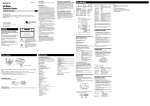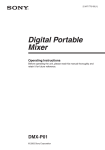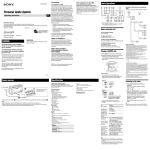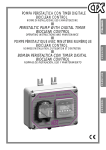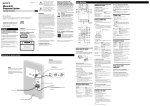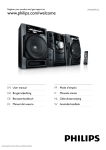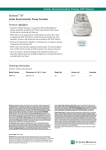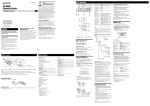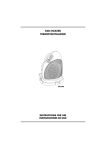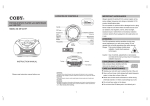Download Sony CFDS01 User's Manual
Transcript
Notes on DualDiscs 2-655-834-34(1) CD Radio Cassette-Corder Operating Instructions GB A DualDisc is a two sided disc product which mates DVD recorded material on one side with digital audio material on the other side. However, since the audio material side does not conform to the Compact Disc (CD) standard, playback on this product is not guaranteed. Music discs encoded with copyright protection technologies This product is designed to playback discs that conform to the Compact Disc (CD) standard. Recently, various music discs encoded with copyright protection technologies are marketed by some record companies. Please be aware that among those discs, there are some that do not conform to the CD standard and may not be playable by this product. Notice for customers in the United Kingdom A moulded plug complying with BS 1363 is fitted to this equipment for your safety and convenience. CFD-S01 Should the fuse in the plug supplied need to be replaced, same rating fuse approved by ASTA or BSI to BS 1362, (i.e. marked with or mark) must be used. © 2005 Sony Corporation Disposal of Old Electrical & Electronic Equipment (Applicable in the European Union and other European countries with separate collection systems) WARNING To reduce the risk of fire or electric shock, do not expose this apparatus to rain or moisture. This symbol on the product or on its packaging indicates that this product shall not be treated as household waste. Instead it shall be handed over to the applicable collection point for the recycling of electrical and electronic equipment. By ensuring this product is disposed of correctly, you will help prevent potential negative consequences for the environment and human health, which could otherwise be caused by inappropriate waste handling of this product. The recycling of materials will help to conserve natural resources. For more detailed information about recycling of this product, please contact your local Civic Office, your household waste disposal service or the shop where you purchased the product. To avoid electrical shock, do not open the cabinet. Refer servicing to qualified personnel only. To reduce the risk of fire, do not cover the ventilation of the apparatus with newspapers, tablecloths, curtains, etc. And do not place lighted candles on the apparatus. To reduce the risk of fire or electric shock, do not place objects filled with liquids, such as vases, on the apparatus. Connect the apparatus to an easily accessible AC outlet. Should you notice an abnormality in the apparatus, disconnect the main plug from the AC outlet immediately. If the plug supplied with this equipment has a detachable fuse cover, be sure to attach the fuse cover after you change the fuse. Never use the plug without the fuse cover. If you should lose the fuse cover, please contact your nearest Sony service station. Radio section Frequency range FM: 87.5 - 108 MHz AM: 531 - 1 611 kHz (9 kHz step) 530 - 1 610 kHz (10 kHz step) IF FM: 10.7 MHz AM: 450 kHz Antennas FM: Telescopic antenna AM: Built-in ferrite bar antenna Cassette-corder section Recording system 4-track 2 channel stereo Fast winding time Approx. 150 s (sec.) with Sony cassette C-60 Frequency response TYPE I (normal): 80 - 10 000 Hz General Speaker Full range: 8 cm dia., 4 , cone type (2) Outputs Headphones jack (stereo minijack): For 16 - 32 impedance headphones Power output 1.7 W + 1.7 W (at 4 , 10% harmonic distortion) Power requirements For CD radio cassette-corder: Malaysia and Singapore models: 230 - 240 V AC, 50Hz Korean model: 220 V AC, 60 Hz Argentine model: 220 - 230 V AC, 50 Hz Other models: 230 V AC, 50Hz 9 V DC, 6 R14 (size C) batteries Power consumption AC 11 W Battery life For CD radio cassette-corder: FM recording Sony R14P: approx. 6 h Sony alkaline LR14: approx. 20 h Tape playback Sony R14P: approx. 3 h Sony alkaline LR14: approx. 12 h CD playback Specifications CD player section System Compact disc digital audio system Laser diode properties Emission duration: Continuous Laser output: Less than 44.6 µW (This output is the value measured at a distance of about 200 mm from the objective lens surface on the optical pick-up block with 7 mm aperture.) Number of channels 2 Frequency response 20 - 20 000 Hz +1/–2 dB Wow and flutter Below measurable limit Sony R14P: approx. 1.5 h Sony alkaline LR14: approx. 7 h Dimensions Approx. 360 × 141 × 235 mm (w/h/d) (incl. projecting parts) Mass Approx. 2.6 kg (incl. batteries) Supplied accessory AC power cord (1) Design and specifications are subject to change without notice. Optional accessory Sony MDR headphones series Do not install the appliance in a confined space, such as a bookcase or built-in cabinet. Power sources Precautions Discs that this unit CAN play On placement • Audio CD • CD-R/CD-RW (CD-DA*) * CD-DA is the abbreviation for Compact Disc Digital Audio. It is a recording standard used for Audio CDs. • Do not leave the player in a location near heat sources, in a place subject to direct sunlight, excessive dust or mechanical shock or in a car subject to the direct rays of the sun. • Do not place the player on an inclined or unstable place. • Do not place anything within 10 mm of the side of the cabinet. The ventilation holes must be unobstructed for the player to operate properly and prolong the life of its components. • Since a strong magnet is used for the speakers, keep personal credit cards using magnetic coding or spring-wound watches away from the player to prevent possible damage from the magnet. Discs that this unit CANNOT play • CD-R/CD-RW other than those recorded in music CD format • CD-R/CD-RW of poor recording quality, CD-R/CD-RW that has scratches or are dirty, or CD-R/CD-RW recorded with an incompatible recording device • CD-R/CD-RW which is finalized incorrectly 1 to AC IN 2 to a wall outlet Connect the AC power cord or insert six R14 (size C) batteries (not supplied) into the battery compartment . Notes on discs • Before playing, clean the CD with a cleaning cloth. Wipe the CD from the center out. If there is a scratch, dirt or fingerprints on the CD, it may cause tracking error. Notes • Replace the batteries when the OPR/BATT indicator dims or when the player stops operating. Replace all the batteries with new ones. Before you replace the batteires, be sure to take out the CD from the player. • To use the player on batteries, disconnect the AC power cord from the player. Before using the unit To turn on/off the power European model: Press OPERATE . Other models: Press POWER . To adjust the volume Press VOLUME +, – . To listen through headphones Connect the headphones to the (headphones) jack . To reinforce the bass sound Press MEGA BASS . “MEGA BASS” appears in the display. To return to normal sound, press the button again. Falling asleep to music 1 Play the music source you want. 2 Press SLEEP to display “SLEEP.” 3 Press SLEEP to select the minutes until the player goes off automatically. Each time you press the button, the indication changes as follows: “60” “90” “120” “OFF” “10” “20” “30”. To cancel the sleep function Press OPERATE (or POWER) to turn off the power. Note When you are playing a tape using this function: If the tape length of one side is longer than the set time, the player will not go off until the tape reaches the end. On operation • If the player is brought directly from a cold to a warm location, or is placed in a very damp room, moisture may condense on the lens inside the CD player section. Should this occur, the player will not operate properly. In this case, remove the CD and wait about an hour for the moisture to evaporate. • If the player has not been used for a long time, set it in the playback mode to warm it up for a few minutes before inserting a cassette. Notes on cassettes • Do not use solvents such as benzine, thinner, commercially available cleaners or anti-static spray intended for vinyl LPs. • Do not expose the CD to direct sunlight or heat sources such as hot air ducts, nor leave it in a car parked in direct sunlight as there can be a considerable rise in temperature inside the car. • Do not stick paper or sticker on the CD, nor scratch the surface of the CD. • After playing, store the CD in its case. On safety • As the laser beam used in the CD player section is harmful to the eyes, do not attempt to disassemble the casing. Refer servicing to qualified personnel only. • Should any solid object or liquid fall into the player, unplug the player, and have it checked by qualified personnel before operating it any further. • Discs with non-standard shapes (e.g., heart, square, star) cannot be played on this player. Attempting to do so may damage the player. Do not use such discs. On power sources • For AC operation, check that the player’s operating voltage is identical with your local power supply (see “Specifications”) and use the supplied AC power cord; do not use any other type. • The player is not disconnected from the AC power source (mains) as long as it is connected to the wall outlet, even if the player itself has been turned off. • Unplug the player from the wall outlet when it is not be used for an extended period of time. • When the batteries are not to be used, remove them to avoid damage that can be caused by battery leakage or corrosion. • The nameplate indicating operating voltage, power consumption, etc. is located at the bottom. • Break off the cassette tab from side A or B to prevent accidental recording. If you want to reuse the tape for recording, cover the broken tab with adhesive tape. Side A Tab for side A Tab for side B • The use of a cassette with more than 90 minutes of play time is not recommended except for long, continuous recording or playback. Cleaning the cabinet • Clean the cabinet, panel and controls with a soft cloth slightly moistened with a mild detergent solution. Do not use any type of abrasive pad, scouring powder, or solvent, such as alcohol or benzine. If you have any questions or problems concerning your player, please consult your nearest Sony dealer. Basic Operations Troubleshooting Selecting the play mode Presetting radio stations General Press MODE until “ 1”, “ ”, “SHUF”, “SHUF” and “ ”, “PGM”, or “PGM” and “ ” appear in the display. Then proceed as follows: You can store radio stations into the player’s memory. You can preset up to 30 radio stations, 20 for FM and 10 for AM in any order. The power is not on. To Select Repeat a single track 1 Press RADIO BAND•AUTO PRESET to Repeat all tracks * VOLUME + , and have a tactile dot. Playing a CD 1 Press CD (direct power-on). 2 Press PUSH OPEN/CLOSE and place a disc Select “ 1” “ ” Then do this Press or to select the track that you want to repeat, then press . Press . Shuffle play “SHUF” Press . Repeat tracks in random order “SHUF” and “ ” Press . Program play “PGM” with the label side up on the CD compartment. To close the CD compartment, press PUSH OPEN/ CLOSE . select the band. • Unplug the headphones when listening through speakers. Noise is heard. 3 Press DISPLAY•ENTER . • Someone is using a portable telephone or other equipment that emits radio waves near the player. Move the portable telephone, etc., away from the player. 2 seconds until “AUTO” flashes in the display. If a station cannot be preset automatically You need to preset a station with a weak signal manually. 1 Press RADIO BAND•AUTO PRESET to select the band. 2 Tune in a station you want. 3 Hold down DISPLAY•ENTER for 2 seconds until the preset number flashes in the display. 4 Press PRESET + or – until the preset number you want for the station flashes in the display. Programed track Repeat programed tracks 3 Press . The player plays all the tracks once. Playing order “PGM” and “ ” Press or then press DISPLAY•ENTER for the tracks you want to program in the order you want up to 20 tracks. Then Press . To cancel selected play mode Track number To Pause playback Stop playback Go to the next track Go back to the previous track Locate a point while listening to the sound Locate a point while observing the display Remove the CD Playing time Press . To resume play, press it again. . . . (forward) or (backward) while playing and hold it until you find the point. (forward) or (backward) in pause and hold it until you find the point. PUSH OPEN/CLOSE Using the display To check the total track number and playing time Press DISPLAY•ENTER in stop mode. To check the remaining time Press DISPLAY•ENTER repeatedly while playing a CD. The display changes as follows: The current track number and playing time The current track number and the remaining time of the current track* The number of tracks left and remaining time on the CD * For a track whose number is more than 20, the remaining time appears as “- -:- -” in the display. Press MODE repeatedly until the selected mode disappears from the display. 5 Press DISPLAY•ENTER . The new station replaces the old one. Tip The preset radio stations remain in memory even if you unplug the AC power cord or remove the batteries. To change the current program CD player The CD does not play or “no dISC” is displayed even when a CD is in place. • Place the CD with the label surface up. • Clean the CD. • Take out the CD and leave the CD compartment open for about an hour to dry moisture condensation. • The CD-R/CD-RW is blank. • There is a problem with the quality of the CD-R/CD-RW, recording device or application software. • Replace all the batteries with new ones if they are weak. The sound drops out. • Reduce the volume. • Clean the CD, or replace it if the CD is badly damaged. • Place the player in a location free from vibration. • Clean the lens with a commercially available blower. • The sound may drop out or noise may be heard when using poor quality CD-Rs/CD-RWs or if there is a problem with the recording device or application software. Radio Reception is poor. Playing preset radio stations • Reorient the antenna to improve FM reception. 1 Press RADIO BAND•AUTO PRESET to select the band. 2 Press PRESET + or – to tune in the stored station. To check the programed track and playing order in the display To check the order of tracks before play, press DISPLAY•ENTER . Every time you press the button, the track number appears in the programed order. There is no audio. 2 Hold down RADIO BAND•AUTO PRESET for The stations are stored in memory from the lower frequencies to the higher ones. Press or then press DISPLAY•ENTER for the tracks you want to program in the order you want up to 20 tracks. Then press . • Connect the AC power cord to the wall outlet securely. • Make sure the batteries are inserted correctly. • Replace all the batteries with new ones if they are weak. Playing a tape 1 Press TAPE (direct power-on). 2 Press , and insert the tape into the tape compartment with the side you want to play facing you. Use TYPE I (normal) tape only. Close the compartment. Make sure there is no slack in the tape to avoid damaging the tape or the unit. Press once if the CD is stopped and twice if the CD is playing. The current program will be erased. Then create a new program following the programing procedure. Tips • You can play the same program again, since the program is saved until you open the CD compartment. • You can record your own program. After you’ve created the program, insert a blank tape and press to start recording. • Reorient the player itself to improve AM reception. The audio is weak or has poor quality. • Replace all the batteries with new ones if they are weak. • Move the player away from the TV. The picture of your TV becomes unstable. • If you are listening to an FM program near the TV with an indoor antenna, move the player away from the TV. Tape player The tape does not move when you press an operation button. • Close the cassette compartment securely. The button does not function or the tape does not play or record. Listening to the radio 1 Press RADIO BAND•AUTO PRESET repeatedly (direct power-on). Each time you press the button, the indication changes as follows: “FM” “AM” 2 Hold down TUNE + or – until the frequency digits begin to change in the display. The player automatically scans the radio frequencies and stops when it finds a clear station. If you can’t tune in a station, press the button repeatedly to change the frequency step by step. When an FM stereo broadcast is received, “ST” appears. Tip If the FM broadcast is noisy, press MODE until “Mono” appears in the display and radio will play in monaural. Changing the AM tuning interval If you need to change the AM tuning interval, do the following: 1 While keeping the RADIO BAND•AUTO • Make sure the safety tab on the cassette is in place. The player starts playing. To Pause playback Press . To resume play, press it again. Stop playback . Fast-forward or rewind* or (fast forward or rewind) . Eject the cassette . * When the tape is wound to the end, press to release or . Recording on a tape 1 Press to open the tape compartment and insert a blank tape with the side you want to record on facing you. Use TYPE I (normal) tape only. Close the compartment. 2 Select the program source you want to record. PRESET and CD pressed, disconnect the AC power cord from the wall outlet. 2 While keeping the RADIO BAND•AUTO PRESET and CD pressed, reconnect the AC power cord to the wall outlet. The tuning interval is changed and “AM 9” or “AM 10” appears in the display for 4 seconds. After changing the tuning interval, you need to reset your preset radio stations. Poor or distorted playback, recording or erasing quality. 3 Press . To record from the CD player, place a CD and press CD . To record from the radio, tune in the station you want. 3 Press to start recording ( is depressed automatically). To Pause recording Stop recording Press . To resume recording, press it again. . Tips • Adjusting the volume or the audio emphasis will not affect the recording level. • For the best results, use wall outlet as a power source for recording. • To erase a recording, proceed as follows: 1 Insert the tape whose recording you want to erase. 2 Press TAPE . 3 Press . • Clean the heads by using dry- or wet-type cleaning cassette (available separately) after every 10 hours of use, before you start an important recording, or after playing an old tape. Failure to clean the tape heads can cause degraded sound quality or an inability of the unit to record or play tapes. For details, refer to the instructions of the cleaning cassette. • The TYPE II (high position) or TYPE IV (metal) tape is being used. Use TYPE I (normal) tape only. • Demagnetize the heads using a commercially available tape head demagnetizer. • Replace all the batteries with new ones if they are weak. After trying the remedies, if you still have problems, unplug the AC power cord or remove all the batteries. After all the indications in the display disappear, plug the AC power cord or insert the batteries again. If the problem persists, please consult your nearest Sony dealer.




